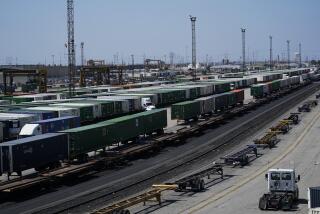Santa Fe Railway Drops $15-Million Hermosa Lawsuit
- Share via
In a surprise move just two weeks before going to go to trial, Santa Fe Railway on Tuesday dropped a 3-year-old lawsuit against the City of Hermosa Beach over the railroad’s abandoned 19-acre right of way, city officials said Wednesday.
The lawsuit, scheduled to be heard in federal court in Los Angeles on Dec. 17, sought $15 million in damages stemming from an ordinance passed by the City Council in August, 1982. The ordinance zoned the right of way--which slices through the city along Ardmore Avenue and Valley Drive--as open space, effectively blocking development of the strip by Santa Fe.
Santa Fe, which had said it hoped to sell the land for residential and commercial development, has valued the right of way at $23 million. City officials, who argue the awkwardly shaped strip would be difficult to develop, set the land’s value at less than $6 million when zoned as open space.
Aside from the beach, the right of way is the largest piece of open space in Hermosa Beach. The landscaped strip is used heavily by joggers and has been equipped with an exercise course by the city. The railroad stopped running trains on the right of way in 1982 and officially abandoned the unprofitable line in 1983, city officials said.
Limit Development
The City Council had voted unanimously to zone the previously unclassified 100-foot-wide strip as open space to limit potential development by Santa Fe. The open-space classification allows trains to travel on the property, but limits other uses to private and public recreation, city officials said. In an advisory ballot proposition in April, 1984, voters overwhelmingly supported purchase of the land by the city, although no purchase is planned.
Benjamin Salvaty, the attorney who handled the suit for Santa Fe, was out of town Wednesday and could not be reached for comment, a Santa Fe spokeswoman said.
R. Bruce Tepper, Jr., an attorney representing Hermosa Beach in the case, said the suit was dismissed without conditions. Tepper and several city officials speculated that Santa Fe dropped the matter in light of various federal and Supreme Court decisions involving open-space issues and appeals of local zoning laws.
In one case, the Supreme Court ruled that property owners must pursue all local avenues of appeal--formally request zoning changes, file subdivision maps, request waivers from the zoning law, for example--before going to court. City officials said Santa Fe has not taken those steps in Hermosa Beach but could still do so--and sue again if the city sticks to its position.
Mayor Jack Wood, one of three incumbent council members who voted for the open-space ordinance in 1982, welcomed the dismissal but bemoaned the legal expenses the city incurred while preparing for the case. City Manager Gregory T. Meyer said the city spent more than $100,000 on the suit.
The Santa Fe lines cut through the heart of the South Bay coastal area, extending from El Segundo in the north to Redondo Beach in the south. Last month, Manhattan Beach officials approved a conceptual agreement with Santa Fe that would allow the railroad to build a 200,000-square-foot commercial development on a portion of the right of way in that city.
Manhattan Beach Mayor Gil Archuletta said the city will reevaluate the agreement with Santa Fe in light of the dismissal of the Hermosa Beach case.
More to Read
Sign up for Essential California
The most important California stories and recommendations in your inbox every morning.
You may occasionally receive promotional content from the Los Angeles Times.













